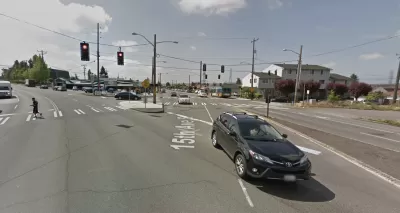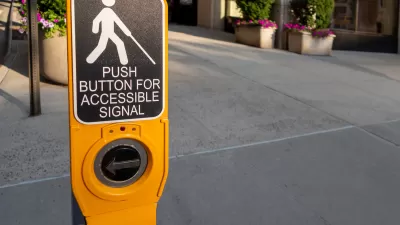Processing a growing backlog of requests, Seattle Department of Transportation must prioritize which intersections will be made accessible.

In Seattle, "the vast majority of pedestrian signals don’t have audible sounds for people who are blind and low vision," reports Heidi Groover, relating the story of a North Seattle resident who is forced to rely on the sound of passing traffic to determine when it's safe to cross the street.
Despite a federal consent decree which requires the installation of more than a thousand curb ramps per year, there's no legislation requiring the addition of Accessible Pedestrian Signals. "More than three quarters of Seattle’s signals do not have such devices," says Groover.
At this point, the Seattle Department of Transportation (SDOT) has a backlog of requests for the installation of accessible signals throughout the city. Even in new intersection construction or alteration projects, replacement of inaccessible signals is not always required, Groover notes. According to Groover, only 22% of pedestrian signals in Seattle are accessible.
One reason for the lack of accessible signals: they're not cheap. "Although SDOT has not produced a formal study of upgrading signals, at $50,000 each, upgrading all 875 crossings without accessible signals would cost about $44 million," writes Groover.
Groover reports that SDOT consults with "an advisory group of people with disabilities to prioritize the requests."
FULL STORY: Many Seattle intersections lack accessible crossing signals for people with vision or hearing loss

Alabama: Trump Terminates Settlements for Black Communities Harmed By Raw Sewage
Trump deemed the landmark civil rights agreement “illegal DEI and environmental justice policy.”

Planetizen Federal Action Tracker
A weekly monitor of how Trump’s orders and actions are impacting planners and planning in America.

The 120 Year Old Tiny Home Villages That Sheltered San Francisco’s Earthquake Refugees
More than a century ago, San Francisco mobilized to house thousands of residents displaced by the 1906 earthquake. Could their strategy offer a model for the present?

In Both Crashes and Crime, Public Transportation is Far Safer than Driving
Contrary to popular assumptions, public transportation has far lower crash and crime rates than automobile travel. For safer communities, improve and encourage transit travel.

Report: Zoning Reforms Should Complement Nashville’s Ambitious Transit Plan
Without reform, restrictive zoning codes will limit the impact of the city’s planned transit expansion and could exclude some of the residents who depend on transit the most.

Judge Orders Release of Frozen IRA, IIJA Funding
The decision is a victory for environmental groups who charged that freezing funds for critical infrastructure and disaster response programs caused “real and irreparable harm” to communities.
Urban Design for Planners 1: Software Tools
This six-course series explores essential urban design concepts using open source software and equips planners with the tools they need to participate fully in the urban design process.
Planning for Universal Design
Learn the tools for implementing Universal Design in planning regulations.
Clanton & Associates, Inc.
Jessamine County Fiscal Court
Institute for Housing and Urban Development Studies (IHS)
City of Grandview
Harvard GSD Executive Education
Toledo-Lucas County Plan Commissions
Salt Lake City
NYU Wagner Graduate School of Public Service





























